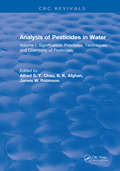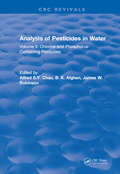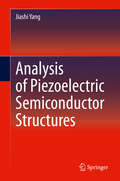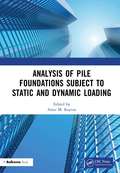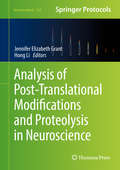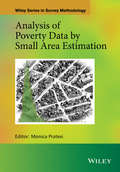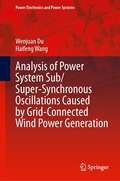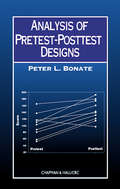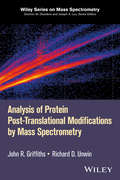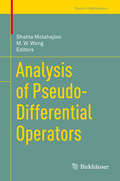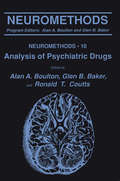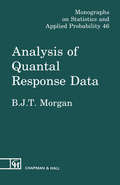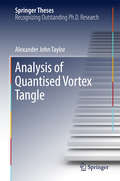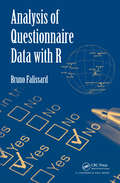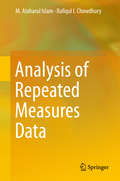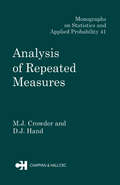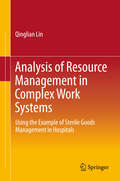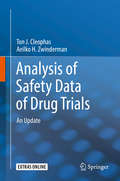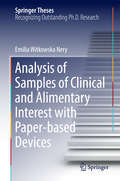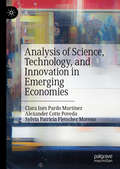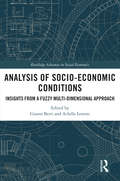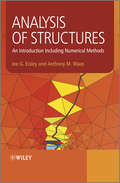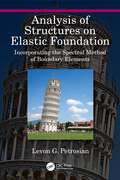- Table View
- List View
Analysis of Pesticides in Water: Volume I: Significance, Principles, Techniques, and Chemistry of Pesticides
by Alfred S.Y. ChauThis book, collected by Mr. Chau and Dr. Afghan, is devoted to the broad and important topic of pesticides. It examines important facets such as the significance of the problem, the chemistry of pesticides, and principles and techniques. It will provide excellent reference material for producers, users and testing agencies.
Analysis of Pesticides in Water: Volume II: Chlorine-and Phosphorus- Containing Pesticides
by Alfred S.Y. ChauThis book, collected by Mr. Chau and Dr. Afghan, is devoted to the broad and important topic of pesticides. It examines important facets such as the significance of the problem, the chemistry of pesticides, and principles and techniques. It will provide excellent reference material for producers, users and testing agencies.
Analysis of Piezoelectric Semiconductor Structures
by Jiashi YangThis book presents the mechanics of piezoelectric semiconductor structures where the main electromechanical coupling of interest is the interaction between mechanical fields and semiconduction. This volume stands as the first full book treatment of this multi-physical subject from the mechanics angle. The analysis of piezoelectric semiconductor structures and devices is an emerging and rapidly growing interdisciplinary area involving materials, electronics, and solid mechanics. It has direct applications in the new area of piezotronics and piezo-phototronics. The book is theoretical, beginning with a phenomenological framework and progressing to include solutions to problems fundamental to the theory and application. Dr. Yang illustrates how in piezoelectric semiconductors, mechanical fields interact with semiconduction through the piezoelectrically produced electric fields by mechanical loads. This provides the foundation of piezotronic and piezo-phototronic devices in which semiconduction is induced, affected, manipulated, or controlled by mechanical fields. Also discussing composite structures of piezoelectric dielectrics and nonpiezoelectric semiconductors as well as thermal effects, the book is an ideal basic reference on the topic for researchers.
Analysis of Pile Foundations Subject to Static and Dynamic Loading
by Amir M. KayniaThis book presents computational tools and design principles for piles used in a wide range of applications and for different loading conditions. The chapters provide a mixture of basic engineering solutions and latest research findings in a balanced manner. The chapters are written by top experts in the field. The materials are presented in a unified manner based on both simplified and rigorous numerical methods. The first four chapters present the basic elements and steps in analysis of piles under static and cyclic loading together with clear references to the appropriate design regulations in Eurocode 7 when relevant. The analysis techniques cover conventional code-based methods, solutions based on pile-soil interaction springs, and advanced 3D finite element methods. The applications range from conventional piles to large circular steel piles used as anchors or monopiles in offshore applications. Chapters 5 to 10 are devoted to dynamic and earthquake analyses and design. These chapters cover a range of solutions from dynamic pile-soil springs to elasto-dynamic solutions of large pile groups. Both linear and nonlinear soil behaviours are considered along with response due to dynamic loads and earthquake shaking including possible liquefaction. The book is unique in its unified treatment of the solutions used for static and dynamic analysis of piles with practical examples of application. The book is considered a valuable tool for practicing engineers, graduate students and researchers.
Analysis of Post-Translational Modifications and Proteolysis in Neuroscience (Neuromethods #114)
by Jennifer Elizabeth Grant Hong LiThis volume highlights proteomics studiesof quantitative PTM changes in both peripheral and central nervous systemproteomes utilizing the most recent advances in mass spectrometry. Chaptersinclude practical information pertaining to the fundamentals of samplepreparation, liquid chromatography, and tandem mass spectrometry instrumentalanalysis and will elucidate best practices in the interpretation of data usingmodern bioinformatics approaches. Written for the popular Neuromethods series,chapters include the kind of detail and key implementation advice that ensuressuccessful results in the laboratory. Authoritativeand practical, Analysis of Post-Translational Modifications andProteolysis in Neuroscience aims to ensure successful resultsin the further study of this vital field.
Analysis of Potential Interference Issues Related to FCC Order 20-48
by Computer Science and Telecommunications Board Division on Engineering and Physical Sciences Board on Physics and Astronomy Air Force Studies Board National Academies of Sciences, Engineering, and Medicine Committee to Review FCC Order 20-48 Authorizing Operation of a Terrestrial Radio Network Near the GPS Frequency BandsThis report reviews Federal Communications Commission order FCC 20-48, which authorized Ligado Networks LLC to operate a low-power terrestrial radio network adjacent to the Global Positioning System (GPS) frequency band. It considers how best to evaluate harmful interference to civilian and defense users of GPS, the potential for harmful interference to GPS users and DOD activities, and the effectiveness and feasibility of the mitigation measures proposed in the FCC order.
Analysis of Poverty Data by Small Area Estimation
by Monica PratesiA comprehensive guide to implementing SAE methods for poverty studies and poverty mapping There is an increasingly urgent demand for poverty and living conditions data, in relation to local areas and/or subpopulations. Policy makers and stakeholders need indicators and maps of poverty and living conditions in order to formulate and implement policies, (re)distribute resources, and measure the effect of local policy actions. Small Area Estimation (SAE) plays a crucial role in producing statistically sound estimates for poverty mapping. This book offers a comprehensive source of information regarding the use of SAE methods adapted to these distinctive features of poverty data derived from surveys and administrative archives. The book covers the definition of poverty indicators, data collection and integration methods, the impact of sampling design, weighting and variance estimation, the issue of SAE modelling and robustness, the spatio-temporal modelling of poverty, and the SAE of the distribution function of income and inequalities. Examples of data analyses and applications are provided, and the book is supported by a website describing scripts written in SAS or R software, which accompany the majority of the presented methods. Key features: Presents a comprehensive review of SAE methods for poverty mapping Demonstrates the applications of SAE methods using real-life case studies Offers guidance on the use of routines and choice of websites from which to download them Analysis of Poverty Data by Small Area Estimation offers an introduction to advanced techniques from both a practical and a methodological perspective, and will prove an invaluable resource for researchers actively engaged in organizing, managing and conducting studies on poverty.
Analysis of Power System Sub/Super-Synchronous Oscillations Caused by Grid-Connected Wind Power Generation (Power Electronics and Power Systems)
by Haifeng Wang Wenjuan DuThis book provides a systematic introduction to power system sub/super-synchronous oscillations caused by grid-connected wind power generation. The authors look at why oscillations occur and present methods for examining the risk of oscillations. Coverage includes state-space model based analysis and impedance model based analysis, which are the two main methods for examining the power system sub/super-synchronous oscillations. In addition, new methods for examining oscillations in wind farms are proposed. Analysis of Power System Sub/Super-Synchronous Oscillations Caused by Grid-connected Wind Power Generation provides researchers and students with a single-volume introduction to the subject and will be a valuable professional reference for practicing engineers looking for solutions to oscillation problems.
Analysis of Pretest-Posttest Designs
by Peter L. BonateHow do you analyze pretest-posttest data? Difference scores? Percent change scores? ANOVA? In medical, psychological, sociological, and educational studies, researchers often design experiments in which they collect baseline (pretest) data prior to randomization. However, they often find it difficult to decide which method of statistical analysis i
Analysis of Protein Post-Translational Modifications by Mass Spectrometry
by John R. Griffiths Richard D. UnwinCovers all major modifications, including phosphorylation, glycosylation, acetylation, ubiquitination, sulfonation and and glycation Discussion of the chemistry behind each modification, along with key methods and references Contributions from some of the leading researchers in the field A valuable reference source for all laboratories undertaking proteomics, mass spectrometry and post-translational modification research
Analysis of Pseudo-Differential Operators (Trends in Mathematics)
by M. W. Wong Shahla MolahajlooThis volume, like its predecessors, is based on the special session on pseudo-differential operators, one of the many special sessions at the 11th ISAAC Congress, held at Linnaeus University in Sweden on August 14-18, 2017. It includes research papers presented at the session and invited papers by experts in fields that involve pseudo-differential operators.The first four chapters focus on the functional analysis of pseudo-differential operators on a spectrum of settings from Z to Rn to compact groups. Chapters 5 and 6 discuss operators on Lie groups and manifolds with edge, while the following two chapters cover topics related to probabilities. The final chapters then address topics in differential equations.
Analysis of Psychiatric Drugs (Neuromethods #10)
by Alan A. Boulton Glen B. Baker Ronald T. CouttsPlaces special emphasis on three major drug classes: antidepressants, antipsychotics, and anxiolytics. Chapters offer detailed information on the methods and techniques for analyzing these drugs. Annotation(c) 2003 Book News, Inc. , Portland, OR (booknews. com)
Analysis of Quantal Response Data
by Byron J.T. MorganThis book takes the standard methods as the starting point, and then describes a wide range of relatively new approaches and procedures designed to deal with more complicated data and experiments - including much recent research in the area. Throughout mention is given to the computing requirements - facilities available in large computing packages like BMDP, SAS and SPSS are also described.
Analysis of Quantised Vortex Tangle (Springer Theses)
by Alexander John TaylorIn this thesis, the author develops numerical techniques for tracking and characterising the convoluted nodal lines in three-dimensional space, analysing their geometry on the small scale, as well as their global fractality and topological complexity---including knotting---on the large scale. The work is highly visual, and illustrated with many beautiful diagrams revealing this unanticipated aspect of the physics of waves. Linear superpositions of waves create interference patterns, which means in some places they strengthen one another, while in others they completely cancel each other out. This latter phenomenon occurs on 'vortex lines' in three dimensions. In general wave superpositions modelling e. g. chaotic cavity modes, these vortex lines form dense tangles that have never been visualised on the large scale before, and cannot be analysed mathematically by any known techniques.
Analysis of Questionnaire Data with R
by Bruno FalissardWhile theoretical statistics relies primarily on mathematics and hypothetical situations, statistical practice is a translation of a question formulated by a researcher into a series of variables linked by a statistical tool. As with written material, there are almost always differences between the meaning of the original text and translated text.
Analysis of Recent Growth in Low-Income CIS Countries
by Elena Loukoianova Anna UnigovskayaA report from the International Monetary Fund.
Analysis of Repeated Measures Data
by M. Ataharul Islam Rafiqul I. ChowdhuryThis book presents a broad range of statistical techniques to address emerging needs in the field of repeated measures. It also provides a comprehensive overview of extensions of generalized linear models for the bivariate exponential family of distributions, which represent a new development in analysing repeated measures data. The demand for statistical models for correlated outcomes has grown rapidly recently, mainly due to presence of two types of underlying associations: associations between outcomes, and associations between explanatory variables and outcomes. The book systematically addresses key problems arising in the modelling of repeated measures data, bearing in mind those factors that play a major role in estimating the underlying relationships between covariates and outcome variables for correlated outcome data. In addition, it presents new approaches to addressing current challenges in the field of repeated measures and models based on conditional and joint probabilities. Markov models of first and higher orders are used for conditional models in addition to conditional probabilities as a function of covariates. Similarly, joint models are developed using both marginal-conditional probabilities as well as joint probabilities as a function of covariates. In addition to generalized linear models for bivariate outcomes, it highlights extended semi-parametric models for continuous failure time data and their applications in order to include models for a broader range of outcome variables that researchers encounter in various fields. The book further discusses the problem of analysing repeated measures data for failure time in the competing risk framework, which is now taking on an increasingly important role in the field of survival analysis, reliability and actuarial science. Details on how to perform the analyses are included in each chapter and supplemented with newly developed R packages and functions along with SAS codes and macro/IML. It is a valuable resource for researchers, graduate students and other users of statistical techniques for analysing repeated measures data.
Analysis of Repeated Measures: A Practical Approach For Behavioural Scientists (Chapman And Hall/crc Monographs On Statistics And Applied Probability Ser. #41)
by David J. Hand Martin J. CrowderRepeated measures data arise when the same characteristic is measured on each case or subject at several times or under several conditions. There is a multitude of techniques available for analysing such data and in the past this has led to some confusion. This book describes the whole spectrum of approaches, beginning with very simple and crude methods, working through intermediate techniques commonly used by consultant statisticians, and concluding with more recent and advanced methods. Those covered include multiple testing, response feature analysis, univariate analysis of variance approaches, multivariate analysis of variance approaches, regression models, two-stage line models, approaches to categorical data and techniques for analysing crossover designs. The theory is illustrated with examples, using real data brought to the authors during their work as statistical consultants.
Analysis of Resource Management in Complex Work Systems: Using the Example of Sterile Goods Management in Hospitals
by Qinglian LinThis book develops and assesses a decision-making model for resource management in complex work systems in line with the Systems Engineering method. It applies the Balanced Scorecard to the development of the criteria system for decision-making, and employs fuzzy linguistics theory to evaluate the alternatives. Further, the book assesses the application of this model in a hospital that has to decide whether or not to outsource its sterile goods. The use of the model opens up a diverse range of fields for decision-making in the area of complex work systems. "
Analysis of Safety Data of Drug Trials: An Update
by Aeilko H. Zwinderman Ton J. CleophasIn 2010, the 5th edition of the textbook, "Statistics Applied to Clinical Studies", was published by Springer and since then has been widely distributed. The primary object of clinical trials of new drugs is to demonstrate efficacy rather than safety. However, a trial in humans which does not adequately address safety is unethical, while the assessment of safety variables is an important element of the trial.An effective approach is to present summaries of the prevalence of adverse effects and their 95% confidence intervals. In order to estimate the probability that the differences between treatment and control group occurred merely by chance, a statistical test can be performed. In the past few years, this pretty crude method has been supplemented and sometimes, replaced with more sophisticated and better sensitive methodologies, based on machine learning clusters and networks, and multivariate analyses. As a result, it is time that an updated version of safety data analysis was published. The issue of dependency also needs to be addressed. Adverse effects may be either dependent or independent of the main outcome. For example, an adverse effect of alpha blockers is dizziness and this occurs independently of the main outcome "alleviation of Raynaud 's phenomenon". In contrast, the adverse effect "increased calorie intake" occurs with "increased exercise", and this adverse effect is very dependent on the main outcome "weight loss". Random heterogeneities, outliers, confounders, interaction factors are common in clinical trials, and all of them can be considered as kinds of adverse effects of the dependent type. Random regressions and analyses of variance, high dimensional clusterings, partial correlations, structural equations models, Bayesian methods are helpful for their analysis. The current edition was written for non-mathematicians, particularly medical and health professionals and students. It provides examples of modern analytic methods so far largely unused in safety analysis. All of the 14 chapters have two core characteristics, First, they are intended for current usage, and they are particularly concerned with that usage. Second, they try and tell what readers need to know in order to understand and apply the methods. For that purpose, step by step analyses of both hypothesized and real data examples are provided.
Analysis of Samples of Clinical and Alimentary Interest with Paper-based Devices (Springer Theses)
by Emilia Witkowska NeryThis book presents two main sets of paper-basedanalytical systems. The first set is a platform for the analysis of glucose,cholesterol and uric acid in biological samples, and the second set is a cutting-edgeelectronic tongue system for the analysis of beverages (mineral water, beer,wine). This thesis also provides an extensive review of 33 methods ofenzyme immobilization on paper which have been evaluated to enhance the storagestability of the proposed system for biomarker detection. From a practical perspective, this thesis coversa diverse set of topics related to paper-based sensing, including colorimetricand electrochemical detection methods, different sets of architecture(spot-tests, lateral and tangential flow assays), methods of fabrication (waxprinting, cutting, impregnation with polymers), measurements instationary and flow conditions as well computer modeling of proposed systemsand sophisticated data analysis using chemometric techniques. This book isuseful for PhD students working in this or a related field who require detailedinformation about methodology and background to this research.
Analysis of Science, Technology, and Innovation in Emerging Economies
by Clara Inés Pardo Martínez Alexander Cotte Poveda Sylvia Patricia Fletscher MorenoThis book outlines a number of different perspectives on the relationship between science, technology, and innovation in emerging economies. In it, the authors explore the aforementioned relationship as a pillar of economic development, driving growth in emerging economies. Employing a collaborative and interdisciplinary approach, the authors work to determine the main related factors and outcomes of the relationship between science, technology, and innovation, ultimately seeking to guide public policies to enhance the welfare of the population of an emerging economy.
Analysis of Socio-Economic Conditions: Insights from a Fuzzy Multi-dimensional Approach (Routledge Advances in Social Economics)
by Gianni Betti and Achille LemmiShowcasing fuzzy set theory, this book highlights the enormous potential of fuzzy logic in helping to analyse the complexity of a wide range of socio-economic patterns and behaviour. The contributions to this volume explore the most up-to-date fuzzy-set methods for the measurement of socio-economic phenomena in a multidimensional and/or dynamic perspective. Thus far, fuzzy-set theory has primarily been utilised in the social sciences in the field of poverty measurement. These chapters examine the latest work in this area, while also exploring further applications including social exclusion, the labour market, educational mismatch, sustainability, quality of life and violence against women. The authors demonstrate that real-world situations are often characterised by imprecision, uncertainty and vagueness, which cannot be properly described by the classical set theory which uses a simple true–false binary logic. By contrast, fuzzy-set theory has been shown to be a powerful tool for describing the multidimensionality and complexity of social phenomena. This book will be of significant interest to economists, statisticians and sociologists utilising quantitative methods to explore socio-economic phenomena.
Analysis of Structures
by Antony M. Waas Joe G. EisleyAnalysis of Structures offers an original way of introducing engineering students to the subject of stress and deformation analysis of solid objects, and helps them become more familiar with how numerical methods such as the finite element method are used in industry.Eisley and Waas secure for the reader a thorough understanding of the basic numerical skills and insight into interpreting the results these methods can generate.Throughout the text, they include analytical development alongside the computational equivalent, providing the student with the understanding that is necessary to interpret and use the solutions that are obtained using software based on the finite element method. They then extend these methods to the analysis of solid and structural components that are used in modern aerospace, mechanical and civil engineering applications.Analysis of Structures is accompanied by a book companion website www.wiley.com/go/waas housing exercises and examples that use modern software which generates color contour plots of deformation and internal stress.It offers invaluable guidance and understanding to senior level and graduate students studying courses in stress and deformation analysis as part of aerospace, mechanical and civil engineering degrees as well as to practicing engineers who want to re-train or re-engineer their set of analysis tools for contemporary stress and deformation analysis of solids and structures. Provides a fresh, practical perspective to the teaching of structural analysis using numerical methods for obtaining answers to real engineering applicationsProposes a new way of introducing students to the subject of stress and deformation analysis of solid objects that are used in a wide variety of contemporary engineering applicationsCasts axial, torsional and bending deformations of thin walled objects in a framework that is closely amenable to the methods by which modern stress analysis software operates.
Analysis of Structures on Elastic Foundation: Incorporating the Spectral Method of Boundary Elements
by Levon G. PetrosianThis book is devoted to the static and dynamic analysis of structures on elastic foundation. Through comprehensive analysis, the book shows analytical and mechanical relationships among classic and modern methods of solving boundary value problems. The book provides a wide spectrum of applications of modern techniques and methods of calculation of static and dynamic problems of engineering design. It pursues both methodological and practical purposes, and the accounting of all methods is accompanied by solutions of the specific problems, which are not merely illustrative in nature but may represent an independent interest in the study of various technical issues. Two special features of the book are the extensive use of the generalized functions for describing the impacts on structures and the substantiations of the methods of the apparatus of the generalized functions. The book illustrates modern methods for solving boundary-value problems of structural mechanics and soil mechanics based on the application of boundary equations. The book presents the philosophy of boundary equations and boundary element methods. A number of examples of solving different problems of static and dynamic calculation of structures on an elastic foundation are given according to the methods presented in the book. Introduces a general approach to the method of integral transforms based on the spectral theory of the linear differential operators. The Spectral Method of Boundary Element (SMBE) is developed based on using integral transforms with an orthogonal kernel in the extended domain. Presents a new, versatile foundation model with a number of advantages over the ground-based models currently used in practical calculations. Provides new transforms which will aid in solving various problems relevant to bars, beams, plates, and shells in particular for the structures on elastic foundation. Examines the methods of solving boundary-value problems typical for structural mechanics and related fields.
